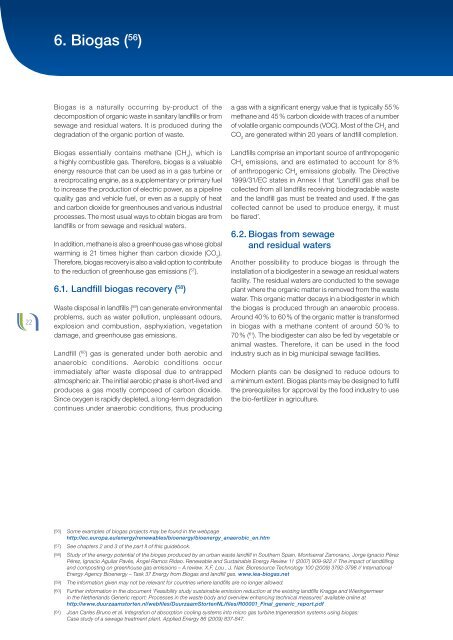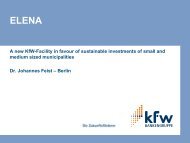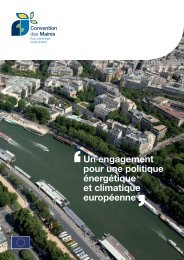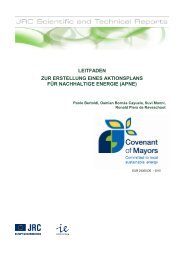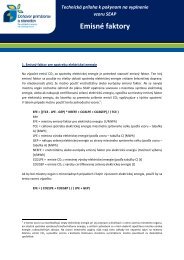English - Covenant of Mayors
English - Covenant of Mayors
English - Covenant of Mayors
You also want an ePaper? Increase the reach of your titles
YUMPU automatically turns print PDFs into web optimized ePapers that Google loves.
6. Biogas ( 56 )22Biogas is a naturally occurring by-product <strong>of</strong> thedecomposition <strong>of</strong> organic waste in sanitary landfills or fromsewage and residual waters. It is produced during thedegradation <strong>of</strong> the organic portion <strong>of</strong> waste.Biogas essentially contains methane (CH 4), which isa highly combustible gas. Therefore, biogas is a valuableenergy resource that can be used as in a gas turbine ora reciprocating engine, as a supplementary or primary fuelto increase the production <strong>of</strong> electric power, as a pipelinequality gas and vehicle fuel, or even as a supply <strong>of</strong> heatand carbon dioxide for greenhouses and various industrialprocesses. The most usual ways to obtain biogas are fromlandfills or from sewage and residual waters.In addition, methane is also a greenhouse gas whose globalwarming is 21 times higher than carbon dioxide (CO 2).Therefore, biogas recovery is also a valid option to contributeto the reduction <strong>of</strong> greenhouse gas emissions ( 57 ).6.1. Landfill biogas recovery ( 58 )Waste disposal in landfills ( 59 ) can generate environmentalproblems, such as water pollution, unpleasant odours,explosion and combustion, asphyxiation, vegetationdamage, and greenhouse gas emissions.Landfill ( 60 ) gas is generated under both aerobic andanaerobic conditions. Aerobic conditions occurimmediately after waste disposal due to entrappedatmospheric air. The initial aerobic phase is short-lived andproduces a gas mostly composed <strong>of</strong> carbon dioxide.Since oxygen is rapidly depleted, a long-term degradationcontinues under anaerobic conditions, thus producinga gas with a significant energy value that is typically 55 %methane and 45 % carbon dioxide with traces <strong>of</strong> a number<strong>of</strong> volatile organic compounds (VOC). Most <strong>of</strong> the CH 4andCO 2are generated within 20 years <strong>of</strong> landfill completion.Landfills comprise an important source <strong>of</strong> anthropogenicCH 4emissions, and are estimated to account for 8 %<strong>of</strong> anthropogenic CH 4emissions globally. The Directive1999/31/EC states in Annex I that ‘Landfill gas shall becollected from all landfills receiving biodegradable wasteand the landfill gas must be treated and used. If the gascollected cannot be used to produce energy, it mustbe flared’.6.2. Biogas from sewageand residual watersAnother possibility to produce biogas is through theinstallation <strong>of</strong> a biodigester in a sewage an residual watersfacility. The residual waters are conducted to the sewageplant where the organic matter is removed from the wastewater. This organic matter decays in a biodigester in whichthe biogas is produced through an anaerobic process.Around 40 % to 60 % <strong>of</strong> the organic matter is transformedin biogas with a methane content <strong>of</strong> around 50 % to70 % ( 61 ). The biodigester can also be fed by vegetable oranimal wastes. Therefore, it can be used in the foodindustry such as in big municipal sewage facilities.Modern plants can be designed to reduce odours toa minimum extent. Biogas plants may be designed to fulfilthe prerequisites for approval by the food industry to usethe bio-fertilizer in agriculture.(56) Some examples <strong>of</strong> biogas projects may be found in the webpagehttp://ec.europa.eu/energy/renewables/bioenergy/bioenergy_anaerobic_en.htm(57) See chapters 2 and 3 <strong>of</strong> the part II <strong>of</strong> this guidebook.(58) Study <strong>of</strong> the energy potential <strong>of</strong> the biogas produced by an urban waste landfill in Southern Spain. Montserrat Zamorano, Jorge Ignacio PérezPérez, Ignacio Aguilar Pavés, Ángel Ramos Ridao. Renewable and Sustainable Energy Review 11 (2007) 909-922 // The impact <strong>of</strong> landfillingand composting on greenhouse gas emissions – A review. X.F. Lou , J. Nair. Bioresource Technology 100 (2009) 3792-3798 // InternationalEnergy Agency Bioenergy – Task 37 Energy from Biogas and landfill gas. www.iea-biogas.net(59) The information given may not be relevant for countries where landfills are no longer allowed.(60) Further information in the document ‘Feasibility study sustainable emission reduction at the existing landfills Kragge and Wieringermeerin the Netherlands Generic report: Processes in the waste body and overview enhancing technical measures’ available online athttp://www.duurzaamstorten.nl/webfiles/DuurzaamStortenNL/files/R00001_Final_generic_report.pdf(61) Joan Carles Bruno et al. Integration <strong>of</strong> absorption cooling systems into micro gas turbine trigeneration systems using biogas:Case study <strong>of</strong> a sewage treatment plant. Applied Energy 86 (2009) 837-847.


